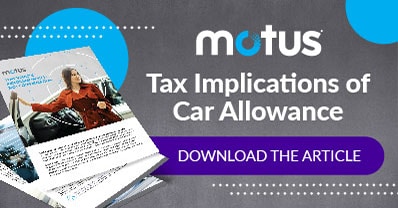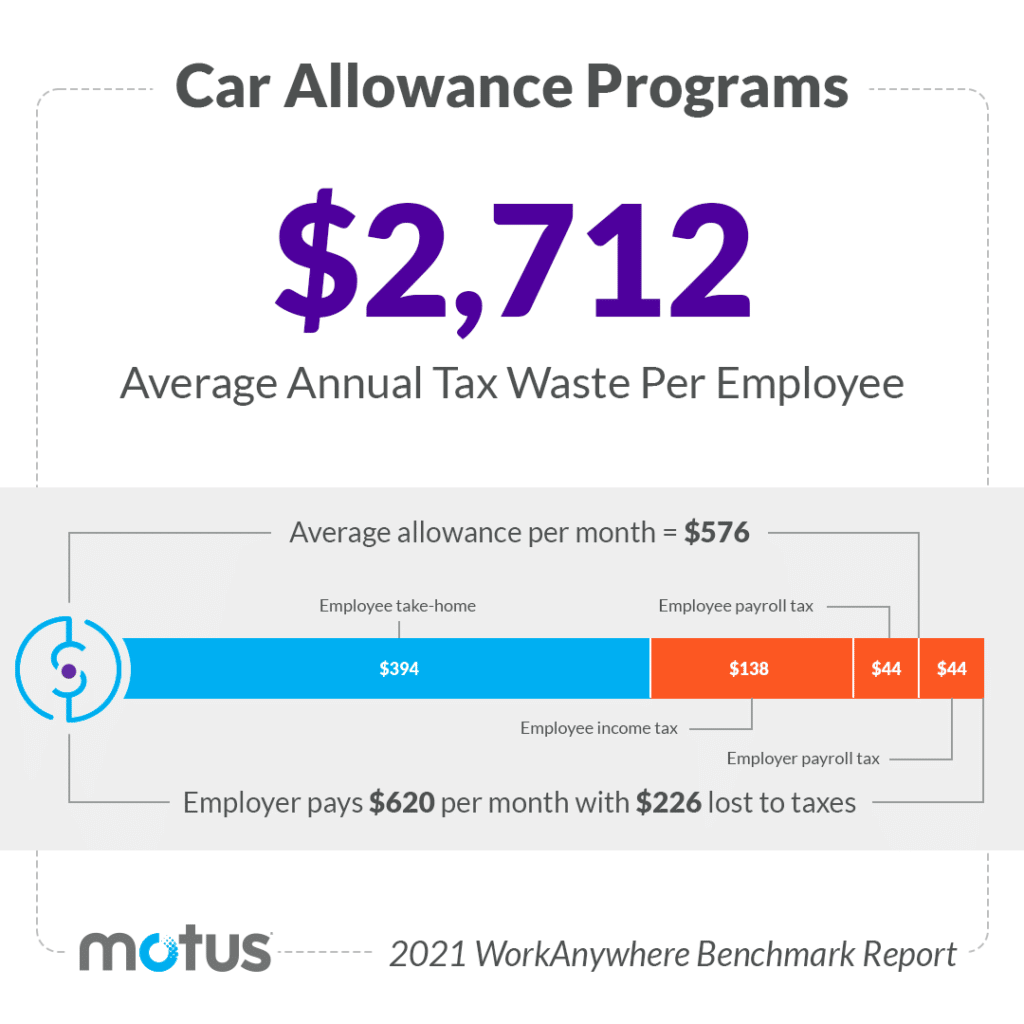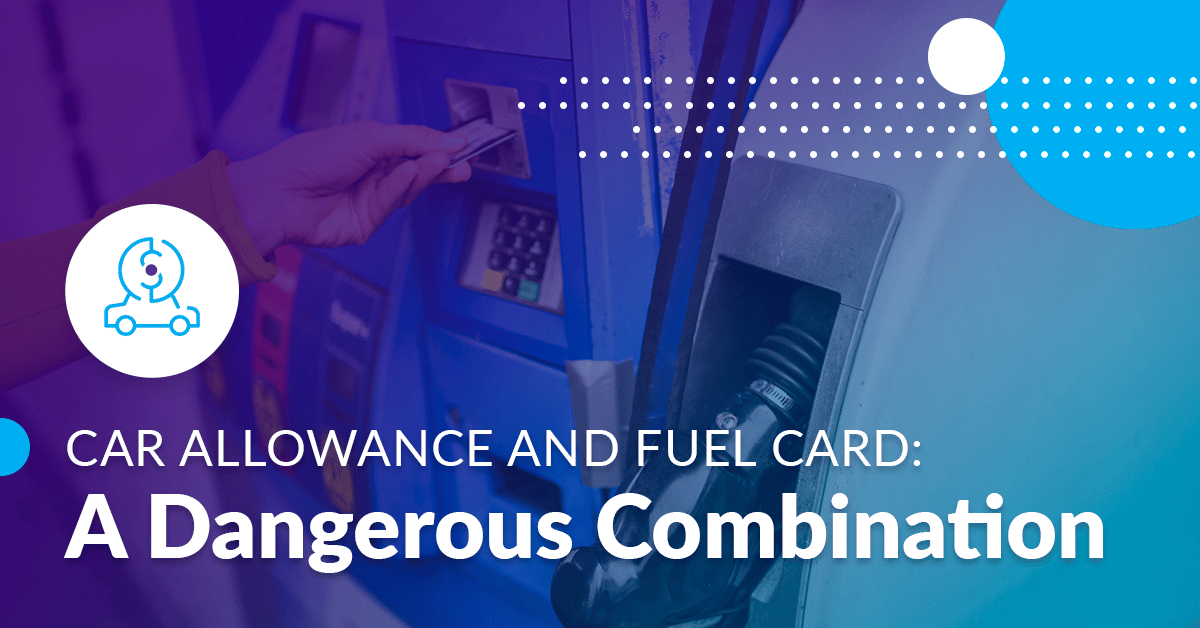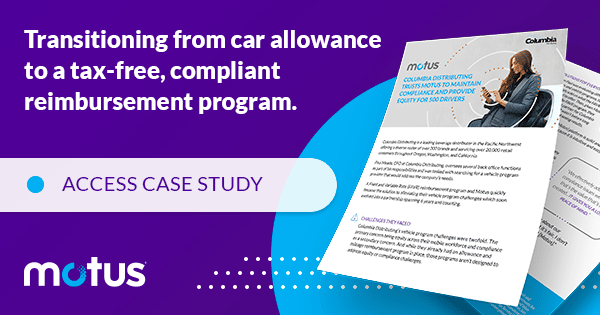Car allowances are popular among many businesses for a number of reasons. For one, they’re easy to implement. For another, they don’t change a whole lot. Each month, companies reimburse employees who drive for work at a flat rate. But does that car allowance change each year? What’s the average car allowance in 2024?
How does a car allowance work?
A car allowance program is when employers provide driving employees a monthly stipend for the business use of their personal vehicle. That stipend remains the same month over month. Other vehicle programs will see vast changes as the industry and its driving employees experience peaks and slumps. Because the stipend remains constant, finance departments have an easier time budgeting for it.
What costs do company car allowances cover?
As previously stated, the monthly stipend is intended to cover the business use of the mobile worker’s personal vehicle. A large portion of that cost is gasoline. However, fuel spend isn’t the only expense of driving a personal vehicle for work. General maintenance like oil changes and tire wear and tear should also be covered by this stipend.
That’s not to say the company should be paying for every oil change, rotation and new part. The car allowance is intended only to cover the expenses of business use. Personal use is expected to be covered by the employee.
What is the Average Company Car Allowance?
The average car allowance doesn’t see much change. The allowance provided will always be based on a person’s role in the company. For example, executives may receive an allowance of around $800, while most mobile workers receive hundreds less. Car allowances are easy to implement and manage, but they also have a staggeringly high cost to employers and employees.
2024 Average Car Allowance
The average car allowance in 2024 is $575. And, believe it or not, the average car allowance in 2020, 2021, 2022 and 2023 was also $575. This amount hasn’t changed much over the past few years because car allowances aren’t as concerned with accuracy as other programs that take mileage and car maintenance into consideration.
How do you calculate your car allowance?
There are many ways a company can go about calculating a car allowance. It can be as simple or as complicated as desired. The simple choice is picking a number, like the average over the past several years. Another method might be to look at the average miles driven by a company’s mobile workforce and multiply that by the IRS mileage rate.
Why is it important to review your car allowance policy?
Car allowances are easy to implement, run and account for. However, they have major failings. Reviewing the program on an annual basis like a company does with other policies can help ensure the amount is updated to account for inflation or other driving expenses. By not reviewing the policy, employees are dipping into their own pocket to cover gas price increases because their monthly stipend of $400 from last year isn’t helping.
The True Cost of the Average Car Allowance
There are two factors that balloon the costs of a car allowance. The first is a fuel card. When gas prices spike and car allowances no longer cover the monthly expenses of driving employees, companies sometimes add fuel cards. With a fuel card, employees no longer need to worry about the rising price of gas. Unfortunately, with a fuel card, it’s the employers that will be worrying.
Simply put, fuel cards are a bad idea. When faced with the problem of car allowances no longer covering employee’s business driving, providing fuel cards simply creates another problem. Now employers have to worry about fuel spend they have no insight into. And then there’s the issue of taxability.
Is car allowance taxable in the US?
Because car allowances are not based on any mileage driven, they are not considered a reimbursement, but additional income. This means they are taxed. This impacts both employers and employees.
Tax Liability for Employee
Employees may be happy with receiving $575. Unfortunately, $575 isn’t what they receive. After income taxes, that amount comes down to $393. This doesn’t mean they’ll unexpectedly owe thousands of dollars come tax season. As with a paycheck, the amount is removed before it reaches their bank account. That doesn’t change the fact that suddenly, that stipend is covering a lot less.
Tax Liability for Company
Employees receiving a car allowance take home a lower amount, and employers pay more for that. For each car allowance of $576, employers pay $620. With only a handful of employees, an additional $44 may not seem like too much. But multiply that amount by 12, across a mobile workforce and the tax waste adds up very quickly.
Inequity in the Average Car Allowance
No two employees drive the same amount for work. Their mileage depends on their regions, their routes, their clients: a whole host of possibilities. Those differences expand when employees are driving in different states. It all boils down to this: each employee’s driving costs are different.
A car allowance of $575—that after taxes comes down to $393—might cover the costs of a low mileage driver. On the other hand, a high mileage driver may find themselves choosing between paying out of pocket for gas or just not driving at all.
Employee Car Allowance Pros and Cons
The pros of the employee car allowance lie in its simplicity. It’s easy to implement, manage and account for. From month to month, nothing changes. This program also benefits low mileage mobile workers. Employees who receive a stipend but don’t drive much may find themselves with a nice leftover sum.
The cons of the program are heavy. Employee car allowances bleed companies with substantial tax waste. They also lack flexibility. When the economic environment shifts, companies with car allowances must scramble for solutions to pay under-reimbursed—and often frustrated—mobile workers. The program also fails to account for costs specific to each individual driver. This often leaves high mileage mobile workers without enough stipend and low mileage ones with more than they need. The program may be easy, but the headaches it creates are not.
Alternatives to Car Allowance
Businesses like car allowances because they’re easy. That ease comes with considerable costs. Companies often remain with costly vehicle programs because they’re unaware of alternatives. When it comes to employer mileage reimbursement, companies have multiple options such as accountable allowance, mileage reimbursement and fixed and variable rate (FAVR) reimbursement.
Accountable Allowance
An accountable allowance is very similar to the typical car allowance. Employees receive monthly stipends to cover the business costs of driving their personal vehicle for work. However, an accountable allowance requires an additional step. Employees must keep records that substantiate business mileage in accordance with IRS regulations. These mileage logs “account” for the mileage they drive, justifying the allowance they receive. Up to the IRS mileage rate, the allowance will not be taxed. Anything above it will.
Mileage Reimbursement
With a mileage reimbursement program, companies reimburse their mobile workers at a cents-per-mile rate. Provided this rate is at or below the IRS mileage rate, the reimbursements are not taxed. As with an accountable allowance, this means employees are required to keep mileage logs. These mileage logs must be IRS compliant. Mileage logs that fail compliance may result in unreimbursed mileage or potentially an IRS audit.
Differences Between Mileage Reimbursement and Car Allowance Programs
The biggest difference between these two programs is accounting for miles. With a car allowance program, employees do not have to track their miles. That makes the program taxable. Mileage reimbursement on the other hand requires employees capture their business mileage to be reimbursed. This ensures that the program is not taxed.
The difference between mileage reimbursement and accountable allowance is far less substantial. Both require mileage logs, and both ensure non-taxed reimbursements (to a point). However, accountable allowances continue to pay the same, anticipated amount each month. Mileage reimbursements depend solely on the mileage each mobile worker drives.
Why Accountable Allowance is a Flawed Solution
An accountable allowance may seem like an easy next step for companies looking to reduce tax waste. It means the employees will receive more accurate stipends and employers won’t pay an additional percentage each month. Unfortunately, the program remains inflexible.
In the situation where gas prices double and high mileage mobile workers drive the expected miles in a month, even an accountable allowance will not cover all their business costs. The accountable allowance only ensures it won’t be taxed. The program still fails to account for driving costs specific to each employee. While the tax waste issue is resolved, employees may remain under-reimbursed.
Employee Mileage Reimbursement Pros and Cons
The list of pros for this program is cut and dry. Companies use mileage reimbursement programs because they’re fairly easy to implement tax-free. A business only needs to ensure they’re reimbursing at the annual IRS mileage rate. As long as employees submit IRS-compliant mileage logs, they receive their reimbursements. But mileage reimbursement programs aren’t for every company.
First, mileage reimbursements are unpredictable. The mileage of each mobile worker may vary based on season, client load, etc. This makes budgeting for the program very challenging. Second, manual mileage logs take time and require significant administrative efforts. Companies can adopt mileage capture apps to curb this burden, but the wrong one can result in serious setbacks and frustrations.
Finally, mileage reimbursements also fail to account for employee specific costs. A mobile worker in California will have a significantly different cost of owning and operating their personal vehicle than a mobile worker in Arkansas. Is it fair to pay both employees the same rate? Mileage reimbursement programs are ideal for a small pool of regional mobile workers with mileage below 500 miles each month.
Why the Fixed and Variable Rate (FAVR) Program is a Better Choice
Car allowances have their perks. Unfortunately, they aren’t worth the associated costs. Other programs may require more set up, but eventually result in less administrative effort, less taxed payments and less inequity in reimbursement.
Consider transitioning to a Fixed and Variable Rate (FAVR) program. Companies reimburse employees for the business use of their personal vehicles. That’s not just a cents-per-mile rate. FAVR takes into account both the fixed costs and variable costs of operating and maintaining a vehicle. Each reimbursement is specific to the person receiving it. What’s more, the FAVR program offers flexibility.
What will your company choose?
We’ve shared the benefits and the drawbacks of the car allowance. We’ve shared the average car allowance in 2024 and pointed out why it doesn’t see a lot of change. And we’ve shared less costly alternatives. We don’t have to look too far back in the rear view to think of a time when markets and costs changed dramatically. In times when cost control is essential, companies with vehicle programs that accurately reflect costs have one less thing to worry over. Learn more about FAVR.











